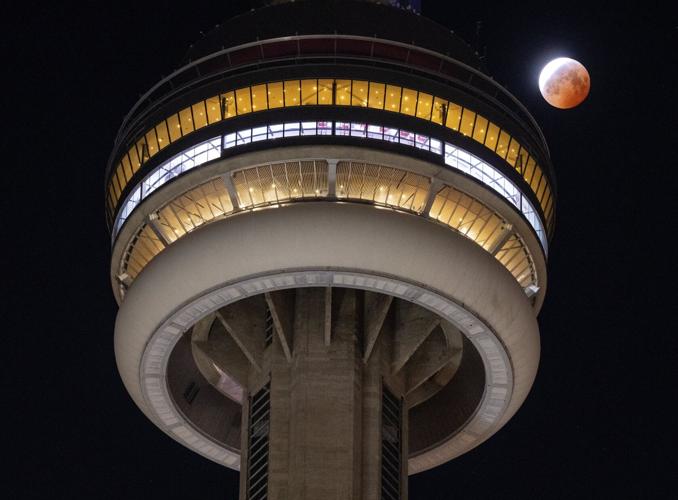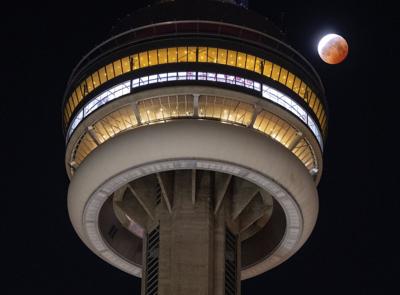Over a period of hours late Thursday night and into early Friday morning, the full moon appeared to be swallowed by a shadow before turning blood red in the night sky.
This dramatic “blood moon” was the first total lunar eclipse visible from Ontario in nearly three years. Many É«É«À²nians were able to catch the phenomenon — even with the bright lights from the city.
“It is very dramatic,” noted Ilana MacDonald, an astrophysicist and public outreach strategist with the University of É«É«À²’s Dunlap Institute for Astronomy and Astrophysics.
MONTREAL - The head of a Quebec aerospace company says he’s thrilled by the confirmation that a private lunar lander has touched down on the m…
MONTREAL - The head of a Quebec aerospace company says he’s thrilled by the confirmation that a private lunar lander has touched down on the m…
“There’s a reason why some early cultures would think this is an omen of some sort,” she said, “because it looks like the moon is being gradually eaten away and then becomes this weird, blood-red colour.”
(AP Video by Victor R. Caivano, Mauricio Cuevas, and Juan Arraez / March 14, 2025)
Here’s why it happens:
What is a total lunar eclipse?
Total lunar eclipses happen when the Earth passes between a full moon and the sun in such a way that its shadow fully covers up the moon.
As the planets slowly move into position, it will look like “little bites are being taken out of the moon until it is completely covered by the Earth’s shadow,” MacDonald described. At that point, it will take on a reddish hue.

A full moon, also known as the “Blood Moon,” is seen during a partial eclipse in the sky over Lake George near the Australian capital city of Canberra on March 14, 2025. Stargazers across a swathe of the world marvelled at a dramatic red “Blood Moon” during a rare total lunar eclipse in the early hours of March 14.Â
IZHAR KHAN AFP via Getty ImagesThis whole process, from when the moon first enters the outer part of Earth’s shadow until it exits out the other side, will take approximately six hours, according to NASA. Totality, or the period where the moon is completely obscured and turns a coppery red, will last about one hour.
“There’s only about two times a year when, during a full moon, the Earth, moon and sun all line up perfectly,” MacDonald said — but these are only visible from certain parts of Earth.
A total lunar eclipse is visible from any one location every “two or three years,” she said. The last time É«É«À² witnessed a total lunar eclipse was in May of 2022.
Why is the total lunar eclipse red?
Take a look at the staggering images of intricate spiral galaxies that reveal new insights into the formation of galaxies, according to NASA.Â
Take a look at the staggering images of intricate spiral galaxies that reveal new insights into the formation of galaxies, according to NASA.Â
Lunar eclipses are red for the same reason that the sky is blue and sunsets are red, Macdonald said.
Sunlight contains a rainbow of different colour wavelengths, each with different properties. Meanwhile, Earth’s atmosphere contains a myriad of different molecules, from gases to dust and water droplets.
According to NASA, blue light is easily scattered in the atmosphere, painting our sky azure when the sun is directly overhead. In contrast, yellow and red light can pass more directly through the atmosphere, giving our sunsets and sunrises a reddish hue as sunlight cuts a longer, lower-angle path to Earth when it nears the horizon.

A full moon, also known as the “Blood Moon,” is seen during a partial eclipse in the sky over Lake George near the Australian capital city of Canberra on March 14, 2025. Stargazers across a swathe of the world marvelled at a dramatic red “Blood Moon” during a rare total lunar eclipse in the early hours of March 14.Â
IZHAR KHAN AFP via Getty ImagesThe moon appears to glow because it reflects light from the sun. But when the Earth blocks out the sun, the only sunlight that can reach the moon is filtered through our atmosphere: “It’s as if all the world’s sunrises and sunsets are projected onto the moon,” NASA said in a blog post.
The exact hue of the moon depends on the day’s atmospheric and weather conditions, MacDonald noted. But its colour can range anywhere from “a reddish orange, a deep reddish brown to a sort of dark brown.
When was the total lunar eclipse?
According to NASA, the moon first entered the Earth’s penumbra, or the outer edge of its shadow, at 11:57 p.m. EST on March 13.
The moon entered the Earth’s umbra, the darkest part of its shadow, at 1:09 a.m. March 14.
Totality, when the moon was fully obscured by Earth’s shadow, started at 2:26 a.m. The moon then took on a blood-red hue.

The full moon, also known as the “Blood Moon,” is seen in Mexico City on March 14, 2025, during a lunar eclipse. Stargazers across a swathe of the world marvelled at a dramatic red “Blood Moon” during a rare total lunar eclipse in the early hours of March 14.Â
YURI CORTEZ AFP via Getty ImagesTotality ended at 3:31 a.m. The red colour then faded.Â
At 4:45 a.m., the moon exited out of Earth’s umbra. Â Finally, the moon fully left the Earth’s penumbra by 6 a.m.
Where was the total lunar eclipse visible in Ontario?
The total lunar eclipse was visible from the Western Hemisphere, which included North America.
“You don’t need any special equipment to view a lunar eclipse. You can just use your eyeballs,” MacDonald said before the lunar event. “It really doesn’t matter where you are, because light pollution doesn’t affect the moon very much because it so bright.”
A total lunar eclipse will flush the moon red across the Western Hemisphere. On Thursday night into Friday morning, the Earth will cast a shadow that totally blocks the moon. (AP Video / March 8, 2025)






































To join the conversation set a first and last name in your user profile.
Sign in or register for free to join the Conversation